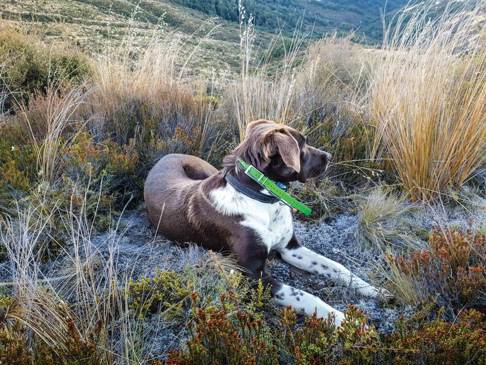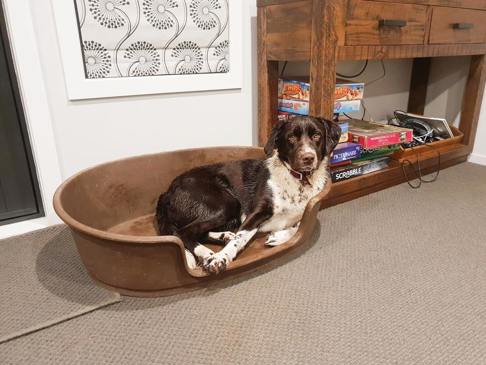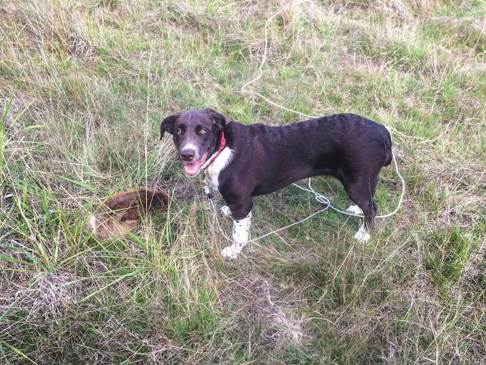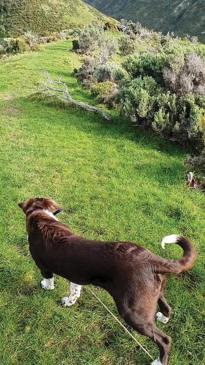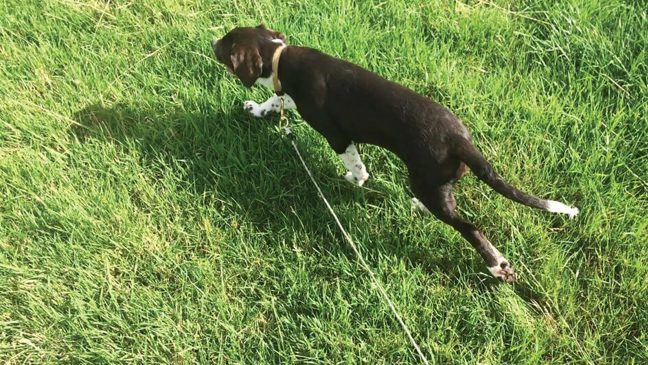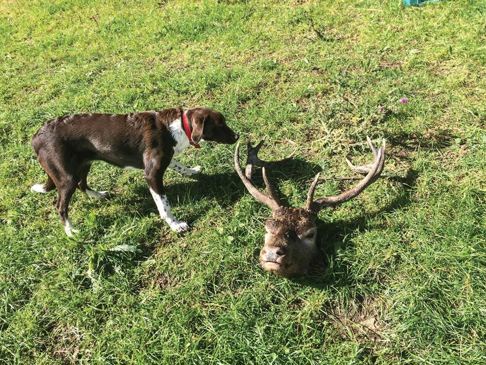Last issue I gave some background on my current journey and some thoughts on picking a pup. I want to emphasise again that your success and fun will depend significantly on the raw material of the dog you are working with.
If you have a calm-natured, intelligent, biddable dog, you will enjoy your journey so much more and vastly increase your chance of success, so choose carefully. My ideal is a dog with hunt drive, but also a temperament that means it really wants to please you, ensuring that when it’s tracking an animal, it also remains naturally aware of not getting too far in front.
If you are picking a pup, be very careful about the breeding, choosing from a proven line. If you are looking at a rehomed dog, look carefully at its nature in relation to the way it has been raised. Getting a rehomed dog at say, twelve months old can help you see exactly what its temperament is like as opposed to a young pup, which in my opinion is a lot harder to read, unless you have spent a huge amount of time around it. Rehomed dogs can come with their own issues, of course.
So, once I had my pup Sami, what did I do next? Before talking about commands, I want to briefly mention mindset. I believe that we need to stop thinking like people when we train dogs and look at everything we do as part of the training process through our dog’s eyes to ensure the messages are clear, simple and consistent.
How do I apply this philosophy? Our dogs need commands they understand and clear boundaries with a line in the sand that we consistently and fairly bring them back to when they stick a toenail over – without being nasty about it. We need to learn to read the signs and be ready to correct behaviours immediately, and most importantly, we need to set our pup up for success. Don’t expect too much of your dog. Teach one command at a time.
Friends and family reckon I am too hard on my dog. I am not hard, I am consistent. When she takes liberties, I bring her back into line. Cutting someone a bit of slack is a human trait. In the dog world it just creates a feeling of insecurity and serves as a platform to take it one step further next time.
My philosophy is that specific training sessions are good to teach a command initially, but once that is learned by the dog, incorporating your training into your daily routine makes it easier for you, and also ensures that the dog’s world remains consistent. The traits and commands you want your dog to learn and comply with become part of its daily routine and therefore mean it is more likely to succeed in all situations.
Consistency is one part, the other is repetition. How do you achieve that? Try and make as many of the commands and things you need for hunting mesh with what you do from day-to-day with your dog. Win-win! So, let’s call this training for the every-day busy person. In my opinion, many dog training videos and prescriptions place too much emphasis on specific training sessions and not enough on daily life. I have seen dogs trained like this that were then taken back into an environment of inconsistency or were so trained that the hunt and independence of thought was almost wrung out of them.
Remember that your dog is a pack animal and most often you and your family are the pack. It is not just about commands and training for a specific role, it is also about how they fit in with the pack and comply with the pack’s social boundaries. I call this ‘manners’. I see some dogs that will comply with specific commands who are also a pain in the butt in everyday situations.
So what are the verbal and non-verbal commands I use with Sami? I will give you a couple of options on several in case you recognise other words for this. I also use whistles and hand signals for several of them.
- Stay/stop
- Here/come
- In/on (walk in front)
- Leave it/no
- Get up/in the box
- On your mat
- OK (release word)
- Steady/slow
These eight commands form the foundation for just about everything I do with Sami. And the funny thing is that of these eight, the only ones I have specifically trained her in are the three highlighted in yellow. The three in blue have been mostly through her learning the body language and voice tone associated with the word. Numbers 5 & 6 were picked up by saying the command when she was doing the action and so she simply and quickly associated the two.
The rest of what she has learned is day-to-day manners. Some examples are:
- Leave strange dogs alone unless I say it is OK to go and say hello.
- Don’t jump up on or lick people.
- Treat small children with the greatest of care.
- Don’t approach strangers unless I say it is OK.
- Don’t bark or whine in your kennel or box.
- Don’t eat unattended food.
- There is only one place in the house if you are allowed in and that is on the mat.
- You are not allowed inside unless invited.
- Don’t chase other animals/leave them alone.
- Kiwis and other birds are strictly off-limits (aversion training and certification).
- Don’t sniff or eat the trap bait in the bucket beside you on the quad when we are working.
There are others, but you get the idea. Everyone has their own set of required manners. Think very carefully about every action you deem is OK for your dog. Too far one way and you risk teaching the dog that it can take liberties and exert dominance. Too far the other way and you risk crushing her spirit and reducing the bond you have with her. Bottom line is that your dog should fit in happily and be easy to have around.
Every dog needs a different level of pressure to achieve what I call ‘happy, secure compliance’ and you need to read your dog carefully.
Don’t be afraid to adjust the pressure as you go, to ensure this. Just make sure that you are consistent. I like Cesar Millan’s philosophy – he preaches ‘calm assertion’, which is a very good description of how you should be with your dog. Apply pressure to behaviours you don’t want and give praise for behaviours you do.
So, where are we going with all this? I believe that much of the initial stage of training your indicator dog, once the base commands are understood, can be simply integrated into you and your dog’s daily routine. This may be a bit different for other hunting disciplines where more specific commands are needed. This can be a huge time saving in some ways, but I actually think the real benefit is that your dog simply considers those commands part of life and not just something that happens on the lawn for ten minutes in the evening.
Don’t get me wrong – training sessions to reinforce commands etc are fine – but training should be part of the whole day, not just a bit of it. I know that skin drags etc can be called training sessions too though. I have my dog around me a fair bit, but in my opinion even if you work away from home for eight hours a day, you shouldn’t have a dog unless it can be fitted in to the remainder of your day at some point. I’ll give you a couple of examples – the first is what I call ‘round home training’.
When I began to teach Sami to stay, I did what others do and made a place board. Google it if you need to – it can be a great tool. With Sami it got used only twice as I could see she was frightened of it, which was going to be counter-productive to the lesson. It wasn’t the chain etc. So the place board went on the burn pile and I put a peg in the ground (she was already trained to be chained up) and clipped her to it.
Then I walked around her issuing the ‘stay’ command and telling her she was a good girl for staying put. She was a lot more relaxed.
Within two sessions, the clip was off and she was staying well with a couple of little corrections. Too easy. After that, I started changing the area and gradually upping the time and distraction. I think I did only four sessions on specifically training the command and then I simply combined it with other stuff I was doing, like having a beer on the deck or working in the workshop; anywhere I could keep one eye on her and correct quickly by simply reissuing the command if her body language said she was getting fidgety.
Within a month I had her stopped rock solid in front of the other dogs’ kennels in the morning when she was amped up as I let the other dogs out. Small point here – once she had been solid for a bit there, instead of just releasing her and letting her flog off after the others, I would call her to me and give her a pat. Then when she was settled, I would release her.
The other thing I did with the ‘stay’ command was to bring her inside and teach her to stay on her mat. That got her in and around the family and around a lot of sudden movements and loud noises which helped (I think) to condition her to that sort of thing and ensure she developed a calm, robust nature.
The next example is ‘out of home training’. What does that mean? Your dog should be walked at least once a day and preferably twice. Dogs need to exercise both their heads and legs. My wife Liz and I have a routine of walking our dogs and having a good catch-up at the same time. When you’re out walking, there are so many opportunities to teach and reinforce the very things you will need your indicator dog to do when you’re hunting. I regularly put a ‘stop’ on Sami and make her wait for us to draw level before I release her.
I also regularly issue the ‘in front’ command for a proportion of the walk and have her doing that all the way home, for example. Sometimes I’ll make a point of adjusting my speed and stopping to get her to match what she does to me. All done while doing what you should be doing every day without the need to take an extra twenty minutes for that when you get home. Put that time into walking further with your dog – better for you both.
The priority is to get the basics right and keep repeating and reinforcing them. I am always making minor changes to what I do as I learn more. Next issue we will go hunting with Sami and talk about the good and the not-so-good. Till then.
Cheers, Johnny

